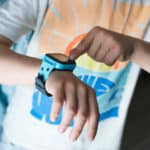
It’s August. The backpacks are lined up. Pencils are sharpened. Lunches are packed.
But if the last few years have taught us anything, it’s that health is just as important as homework—and that back-to-school prep goes far beyond school supplies.
At Hudson Physicians, we believe in supporting the whole health of your child.
That includes keeping up with annual adolescent physicals and vaccinations—but also paying attention to emerging trends in student wellness that can impact your child’s day-to-day life and long-term success.
Here’s a look at what’s shaping student health in 2025—and what families in Hudson and New Richmond can do to stay ahead of the curve.
Mental Health Is a Priority—Not a Luxury
Mental health continues to be a top concern in schools. According to the CDC, more than 40% of U.S. teens reported persistent feelings of sadness or hopelessness in the past year.
The good news? Schools are expanding resources:
- On-site mental health counselors
- Peer support programs
- Digital tools like mental health apps and chat-based early intervention
Even mindfulness and sleep education are being built into the school day.
What you can do as a parent
- Talk openly about feelings. Normalize emotions without judgment.
- Frequent check-ins with your child about their emotional well-being.
- Ask your provider if additional screening or support might be beneficial.

Personalized Nutrition for Growing Bodies
Nutrition is getting smarter. And in 2025, we’re seeing:
- Functional foods that support focus and gut health (think: omega-3s, fiber-rich snacks, and fermented foods)
- AI-powered nutrition apps that suggest meals based on age, allergies, and even activity levels
What’s trending in kids’ lunchboxes? Foods that are colorful, crunchy, low in added sugars, and rich in whole ingredients.
Try this at home:
- Let your child help plan meals or snacks
- Include a probiotic-rich option like yogurt or kefir
- Offer smart swaps: sliced fruit over fruit snacks, trail mix over chips
Wearables: Health Tracking Goes to Homeroom
Wearable tech is more than a step counter—it’s evolving to:
- Track sleep and stress levels
- Alert for irregular heart rhythms
- Monitor hydration or body temp
Many tweens and teens are now wearing smartwatches or fitness bands. When used well, these devices can spark great conversations about habits and self-care.
Tip: Look for kid-friendly wearables with parental privacy controls.

Holistic Wellness Gets a Seat at the Table
We’re seeing a shift toward integrative health for kids—treating the body and mind as a connected system.
- After-school yoga or mindful movement
- Using essential oils or herbal teas to support sleep and focus
To Support Sleep:
- Lavender essential oil: Diffuse in the bedroom or apply (diluted) to the wrists or pillow to promote relaxation and improve sleep quality.
- Chamomile tea:A caffeine-free herbal tea known for its calming properties—great as a bedtime ritual.
- Cedarwood essential oil:Often used in diffusers or bathwater for its grounding, soothing effects.
To Support Focus:
- Peppermint essential oil: Inhaling this scent can help improve alertness and concentration during homework or study time.
- Lemon balm tea: Supports calm focus and is gentle enough for teens—ideal during high-stress school weeks.
- Rosemary essential oil: Known to help with memory retention and mental clarity—can be diffused or used in a personal inhaler.
- Increased acceptance of neurodiverse learning needs and social-emotional support in classrooms – more schools understand that kids learn and feel differently, and they’re doing a better job helping everyone succeed—both with learning and with feelings.
What you can do:
- Ask your child what makes them feel calm, focused, or connected
- Encourage creative outlets like journaling or drawing
- Talk to your healthcare provider about safe, natural tools that complement traditional care
Preventive Care Matters More Than Ever
Annual adolescent physicals and vaccines remain essential—but they’re only part of the puzzle. Physicals are a chance to:
- Track development
- Catch vision, hearing, or behavioral concerns early
- Ask about sleep, nutrition, puberty, and screen time
- Refill necessary medications
- Complete required forms for school or sports
Don’t wait for the school year crunch—schedule now to avoid the end-of-summer rush.

Red Flags to Watch For
As kids head back to class, keep an eye out for subtle signs that something might be off:
- Sudden change in appetite, sleep, or mood
- Complaints of headaches, stomachaches, or fatigue without a clear cause
- Withdrawal from friends or activities
- Trouble concentrating or remembering things
If your child just “doesn’t seem like themselves,” it’s worth a check-in—with you, with a teacher, or with your provider.
What Causes Fatigue in Kids?
Fatigue can be tricky—it might seem like laziness, but it’s often rooted in real causes.
Here’s what to look for:
The 3 levels of fatigue:
- Physical – tired muscles, soreness, reduced energy
- Mental – poor concentration, irritability, forgetfulness
- Emotional – burnout, sadness, loss of motivation
Common causes:
- Iron deficiency or anemia
- Vitamin D deficiency
- Inadequate sleep
- Chronic stress or anxiety
- Underlying infections or immune issues
One surprising source? The liver—an organ central to detoxification and metabolism. If it’s not functioning optimally, fatigue can follow.
If fatigue lingers for more than a week or two, it’s worth scheduling an exam.
Back-to-School = Time to Check In
The transition back to school isn’t just about buying supplies—it’s about setting your child up for success, from head to toe.
At Hudson Physicians, we’re here to support your child’s growth, confidence, and well-being—with a modern, proactive approach to care.
Call today to schedule your adolescent’s back-to-school physical—and let’s make this year their healthiest yet.
